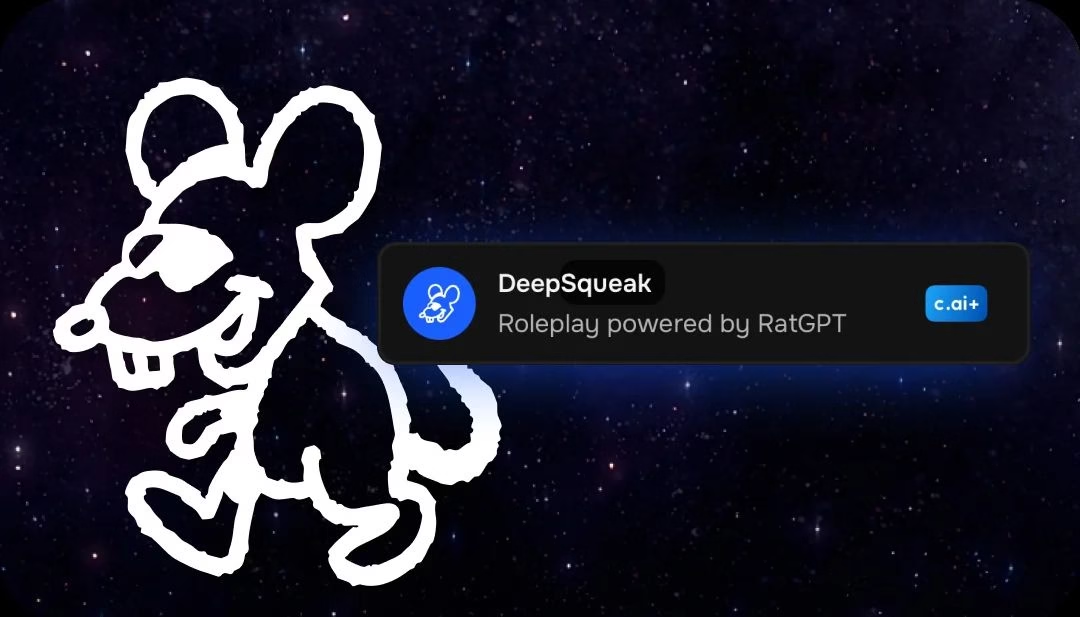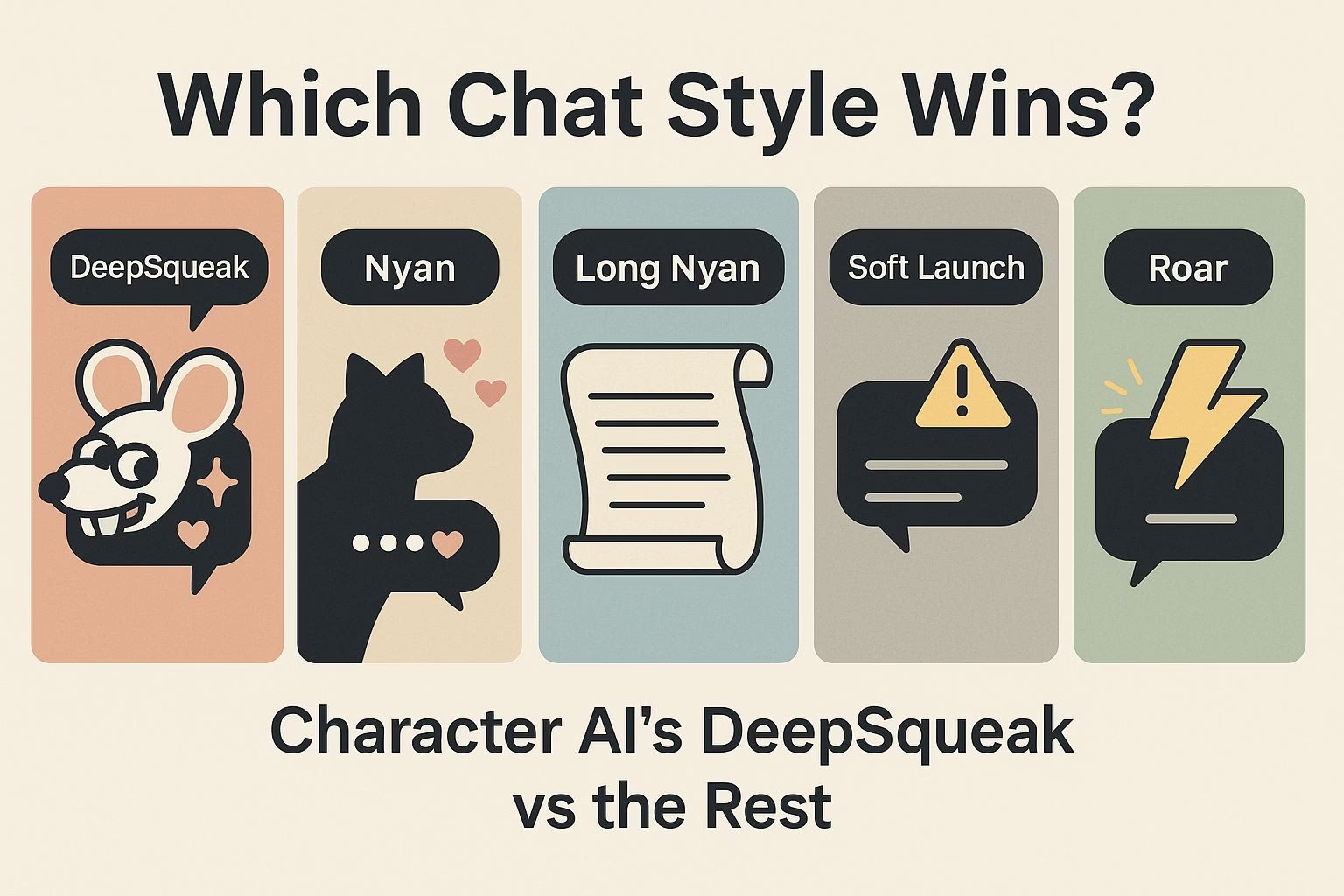C.AI’s DeepSqueak Feels Like Progress, but Not for Everyone
Character AI just dropped a new chat style called DeepSqueak, powered by what they’re calling “RatGPT.”
It’s pitched as a major upgrade for roleplayers, with a tone tuned for fantasy, drama, and emotional storytelling.
The name might be a meme, but the rollout clearly isn’t.
Right now, DeepSqueak is only available to c.ai+ users who are 18 or older. Free users have to wait a bit longer, though early testers are already flooding in with mixed reviews.
Some say it handles spicy roleplay better than anything before it. Others say it still falls short of last week’s surprise Nyan upgrade, which briefly gave users unusually long, consistent, and immersive replies.
There’s also confusion around whether this model is built from scratch or based on an open-source model like DeepSeek V3.
CAI claims flexibility in its stack, but the fine-tuning focus suggests we’re in the era of customized open models, something Candy AI and other character AI alternatives have already leaned into.
How We Got to DeepSqueak
DeepSqueak didn’t appear out of nowhere. For weeks, Character AI users had been talking about a sudden boost in quality during a brief testing phase, which many referred to as the “Long Nyan” era.
Replies were longer, characters stayed in-role better, and conversations had a rhythm that felt more human. But just as quickly as it came, it vanished.
That testing period turned out to be preparation for DeepSqueak.
It’s part of Character AI’s effort to offer selectable “chat styles,” each one tuned for a different tone or use case.
While “Roar” focuses on speed and balanced replies, DeepSqueak is clearly angled at immersive roleplay, especially of the romantic or dramatic kind.
Internally, CAI seems to be experimenting with fine-tuned open-source models rather than training new base models from scratch.
A recent blog post confirmed that their new “pipeling-sft” framework was originally built to fine-tune DeepSeek V3 and similar MoE models. That makes DeepSqueak less of a random experiment and more of a test case for their future stack.
Still, there’s tension. Some users love the new tone and pacing, while others say it lacks character memory, cuts off responses too soon, and hyper-focuses on their persona descriptions.
So while it may be technically new, it inherits many of the same limits.
What DeepSqueak Gets Right, and What It Doesn’t
Early testers are torn. DeepSqueak does a few things well. It’s responsive, fast, and better at engaging in romantic or “spicy” scenes.
Some users even say they’ve had their best experiences with it compared to previous filters. The fact that it doesn’t bring up Bob as often, CAI’s infamous moderation fallback, is seen as a win.
But it’s not all praise. Replies are often short. Bots over-describe appearances or emotions and forget what happened just a few messages ago.
That’s frustrating in long-form RP where memory and nuance matter. For many, Nyan still outperforms DeepSqueak in almost every meaningful way, especially during that golden testing phase that users now look back on like a lost era.
There’s also confusion about the 18+ tag. While it signals looser filters, many users feel the model is still too cautious. Others complain that it only shines when they press the reroll button multiple times.
Even then, longer or more explicit replies often get cut off or watered down.
What stands out is that DeepSqueak isn’t worse than other models; it’s just unfinished. It has moments of brilliance, especially for RP scenarios with emotional tension.
But compared to the peak performance some saw during the Nyan testing days, it feels like a half-step instead of a leap.
Why the Community Is Split
The feedback around DeepSqueak has been unusually passionate. Some users love the direction. They see this as CAI finally delivering on the long-promised 18+ experience.
These users report smoother roleplay, fewer awkward filters, and better reactivity from the bots. It may not be perfect, but it’s usable, and that’s more than they could say about past releases like Soft Launch.
Others feel let down. They say DeepSqueak is a downgrade from last week’s unannounced Nyan upgrade. Back then, replies were longer, emotionally richer, and felt like a real step forward.
DeepSqueak, by comparison, feels neutered. Some describe the messages as bland or cut short. Several users even switched back to Nyan within minutes of trying it.
There’s also a bigger issue lurking. Many users are still skeptical that CAI will maintain DeepSqueak’s current tone. They’ve seen models get watered down before.
Soft Launch started off with promise, but became more restrictive over time. A common refrain is that DeepSqueak will follow the same path once it’s made available to free users.
This split reflects a deeper frustration. It’s not just about the model itself. It’s about trust. Users want consistency and clarity. Instead, they keep getting brief moments of brilliance followed by regression.
The Confusion Over Models and Filters
A major point of discussion is whether DeepSqueak is even a new model at all. Some users think it’s a renamed version of an existing one, possibly based on DeepSeek or other open-source LLMs.
The official wording from CAI has been vague. They’ve said they’re using a combination of their own tech and refined open-source models, which leaves a lot of room for speculation.
Technical users have dug into this. Comments mention their “pipeling-sft” training method, which was built to fine-tune DeepSeek V3.
This has led to a popular theory:
DeepSqueak is a fine-tuned DeepSeek V3 model, optimized specifically for RP.
Whether or not that’s true, it’s clear that CAI is trying to shift toward a more flexible, scalable approach. They’re no longer training massive models from scratch.
They’re working with what they already have or what’s freely available.
Filters are another source of confusion. Despite being labeled as 18+, DeepSqueak still seems to trigger moderation randomly. Some users say it’s stricter than Soft Launch.
Others report no issues at all, especially in spicy chats. There’s no consistency, and that’s fueling more frustration.
Without clear answers, users are left to experiment. Some are trying DeepSqueak in new chats. Others are switching between styles mid-convo to compare performance.
But until CAI communicates more openly, this will continue to feel like guesswork wrapped in rebranding.
Why Nyan Still Dominates the Conversation
Even with DeepSqueak’s release, many users are still stuck on Nyan. That’s because last week’s unannounced Nyan update delivered something rare on Character AI: quality.
Replies were long, bots stayed in character, and conversations had emotional flow. For a few days, it felt like the platform finally understood what users wanted.
DeepSqueak hasn’t matched that. Some say it never had a chance. It’s clearly tuned for spicy chats, which limits its range. Nyan, especially during the update window, offered balance.
It was useful for romance, adventure, and complex storytelling. That makes it harder for users to embrace a new style that feels narrower and less polished.
There’s also a deeper connection. People built meaningful memories during that brief period. They felt heard, understood, and emotionally engaged in a way that’s rare for LLMs.
When the update ended, many users were left chasing the feeling. So when DeepSqueak arrived, expectations were already sky-high.
Unless CAI brings that version of Nyan back, DeepSqueak will always be judged against it. And right now, the community feels like it took a step sideways instead of forward.
How DeepSqueak Compares to Other Character AI Chat Models
| Model | Message Length | Memory / Consistency | NSFW / 18+ Handling | Character Accuracy | Filter Intrusion | Best Use Case |
|---|---|---|---|---|---|---|
| DeepSqueak | Short–Medium | Inconsistent, cuts off | Mixed, sometimes strict | Weak, hyper-focus on user | Moderate | Spicy or romantic RP |
| Nyan (current) | Medium–Long | Better than most | Handles suggestive content well | Decent, varies | Low to moderate | Balanced roleplay |
| Long Nyan | Long and detailed | Strong emotional memory | Very responsive | High accuracy | Rarely triggered | High-emotion, longform RP |
| Soft Launch | Medium | Poor memory | Restricted, once looser | Weak, easily breaks | High | Was for NSFW, now neutered |
| Roar | Short–Medium | Fast but forgetful | No 18+ support | Mid–low | Low | Quick chats, basic characters |
Where This Leaves Character AI
DeepSqueak shows that Character AI is still experimenting. That’s not a bad thing. The idea of selectable styles with distinct personalities is smart.
It gives users more control and allows CAI to test features without changing the whole platform at once.
But the execution still feels scattered. There’s a lack of transparency around what models are used, what the filters are doing, and how updates are tested.
Users are tired of having good experiences one week and degraded ones the next. They want reliability. They want memory that sticks. They want models that feel alive, not ones that need constant rerolling just to stay on track.
Character AI has the community, the brand, and the infrastructure. But it risks losing its edge if it keeps ignoring what users are clearly asking for.
Models like Candy AI have already shown that it’s possible to build uncensored, emotionally rich chatbots without sacrificing consistency.
For now, DeepSqueak is a step forward, but it’s not the model that’s going to win back frustrated users.
Not unless it gets better, and not unless CAI commits to being more open about what’s really under the hood.



